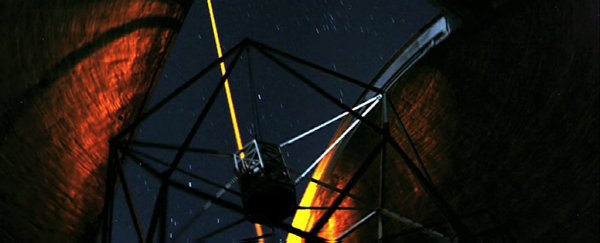An international team of scientists has found the faintest early-Universe galaxy ever, catching a glimpse of the star system as it would have looked some 13 billion years ago, shortly after the Big Bang itself.
The discovery came courtesy of the W. M. Keck Observatory in Hawaii – which is the most powerful telescope on Earth – and we were able to see it thanks to the gravitational lensing phenomenon popularly associated with Einstein.
"Keck Observatory's telescopes are simply the best in the world for this work," explained one of the research team, Maruša Bradač, from the University of California, Davis (UC Davis). "Their power, paired with the gravitational force of a massive cluster of galaxies, allows us to truly see where no human has seen before."
For those who need a refresher, gravitational lensing is when an object is magnified by the gravity of another object, bending its light before it reaches any observers (in this case, the scientists in Hawaii).
And the object used to magnify the incredibly faint galaxy was a massive galaxy cluster officially known as MACS2129.4-0741.
In fact, MACS2129.4-0741 is so big that it enabled astronomers to create three different images of the newly discovered galaxy, all thanks to gravitational lensing.
"If the light from this galaxy was not magnified by factors of 11, five, and two, we would not have been able to see it," said Kuang-Han Huang, also from UC Davis, and the lead researcher of the study.
The discovery should give astronomers and astrophysicists some clues as to what caused hydrogen ionisation – the process by which all those billions of years ago, one of the fundamental questions being asked in astronomy today, according to W. M. Keck Observatory staff astronomer Marc Kassis.
During this mysterious period, large, dense clouds of hydrogen gas sat between galaxies, which has made it impossible for us to see the light from that time.
But then those gas clouds suddenly ionised - which means the electrons became trapped by atomic nuclei - a process that lit up the stars for the first time and made the Universe become transparent.
The team says it's likely that this newly spotted galaxy helped drive the ionisation process.
Another instrument, the Deep Extragalactic Imaging Multi-Object Spectrograph (DEIMOS), was also used to make the discovery. DEIMOS itself is capable of capturing light from 1,200 objects at once with a specially designed narrow-band filter. Data from the Hubble telescope helped to verify the finding too.
Last year, Hubble was responsible for spotting other faint, early galaxies, and as the amount of data scientists have to work with increases, we're slowly begining to piece together more and more of the early history of the Universe.
The findings are published in The Astrophysical Journal Letters.
